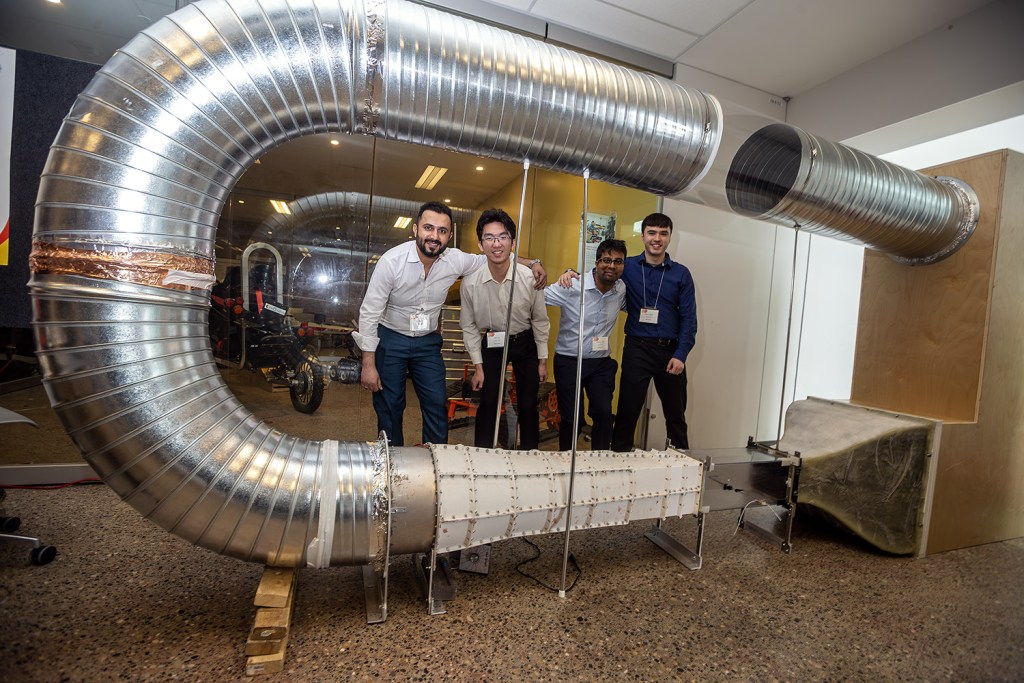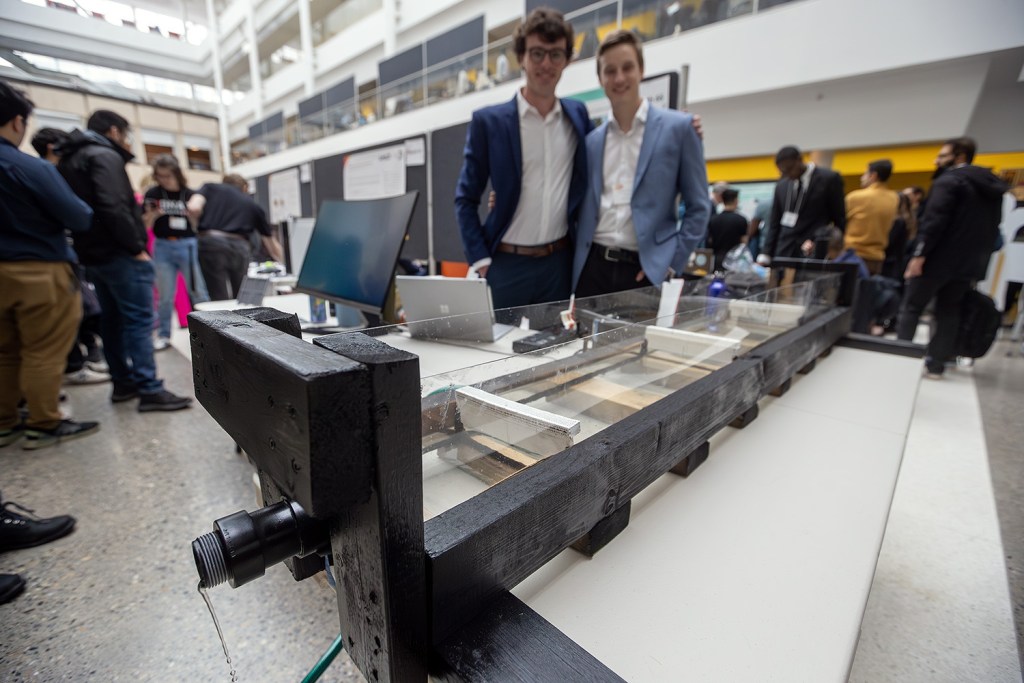It’s hard to not turn on a television or open a newspaper—or even browse the Daily FLIP—without seeing politicians and community leaders talk about the problems that we all face as a province.
From devastating wildfire seasons to national defence concerns, and even more local issues like finding ways of saving tax dollars and having enough clean water for Calgarians: Those problems are pervasive and discussion of them is frequently less than persuasive that solutions are on the way.
Visitors to the annual UCalgary engineering department capstone project fair though, which occurred on April 4, might be persuaded otherwise.
Projects from teams running the gamut of topics from in-air carbon capture, to creating accessible bikes for people with amputated limbs, to real-world applications of machine learning and AI, showed how students are leading the way to solving some of Alberta’s trickiest troubles.
“There are disciplines that focus on trying to tell you what the problem is. Engineering is focused on trying to find solutions to problems or creating something, to create opportunity beyond what we have right now,” said Dr. Bill Rosehart, Dean of the Schulich School of Engineering at UCalgary.
“It’s exciting when you hear about students working on water purification on Tsuut’ina. We had a group of students today that were presenting the new bike design for somebody who had upper above-the-knee amputation. That is engineering at its heart, making our lives better. Often behind the scenes and so many ways—there’s engineering that we don’t even think about that’s there.”
A focus for the 2024 capstone projects, said Dr. Rosehart, was on having real-world industry connections to the projects. Each of the projects had to have a sponsor, be it firms like Lockheed Martin or governments like the Tsuut’ina nation.
“We want it to be real world,” he said.
“We actually have an entrepreneurial capstone stream as well, for students that have a project that they think there’s a potential for launching a company afterward. So, they work on the technical part of their project and in parallel, and we give them foundations on how to launch a startup. We have a few of those floating around today.”

Solving water issues on Tsuut’ina nation
A current issue facing the Tsuut’ina Nation is the growth of filamentous algae in the Nation’s greywater lagoon.
The challenge, said engineering student Anita Malekian, is to pump the water to a sufficient degree to ensure that it can be safely returned to the environment.
“They’re currently using a 20 liter per second Honda trash pump, which helps mitigate the issue to a certain extent, but they’re looking for room for improvement. They wanted a solution that’s autonomous and primarily run by renewable energy,” she said.
The team developed a system using a solar-powered centrifugal pump that allows for dirty water to be sucked up in a hose on one side and then deposited as cleaner water on the other.
Malekian said they were originally connected to the Nation through Water Movement, a non-profit focused on helping to solve Indigenous water issues throughout Canada.
“They essentially told Water Movement this is the issue they’ve been dealing with, and Water Movement connected us to help work with them. We’re hoping to make a scalable solution that can be used by First Nation communities across Canada,” Malekian said.
Team member Haaziq Altaf said that the current cost for the system on Tsuut’ina was around $16,000 per year, but their solution was around $40,000 annually. The cost was higher upfront, but there would be a savings in both the fuel required to run the Honda pump and in terms of how much labour it would require to maintain, Altaf said.
“It takes about two-and-a-half years for our system to become more profitable, and in the long run helps the Tsuut’ina to be more autonomous in their operation,” Altaf said.
“The operator currently has to go in and refuel the pump that they’re using with gasoline. They have to go to a gas station, they have to check if it’s working, but our system is so autonomous that they just have to come in maybe once or twice in a day to just make sure everything’s working and maybe even start the pump.”

Setting the stage for future carbon capture systems
Another UCalgary capstone project on display was a closed loop wind-tunnel system, designed to test the efficacy of carbon capture solutions from the air.
Muhammad Faroq, one of the students on the project, said that their conversion of the wind tunnel allowed them to create a system that will allow for future research into carbon capture solutions.
“Current carbon capture focuses on carbon storage. So putting it underground. What we’re doing is trying to use porous media or packed bed media to see if we could capture carbon that way,” Faroq said.
That process works like water being put through a filter with different layers, although in the case of airflow and carbon in more sophisticated ways that frequently involve chemical reactions between the carbon and elements of the media.
“It focuses on chemical reactions, like calcium hydroxide with CO2 becoming calcium carbonate,” he said.
Faroq said that their capstone project would remain at the university for future students to use under direction from Dr. Robert Martinuzzi, associate head of research at the Schulich School of Engineering at UCalgary.
“Different future capstone projects will be based on this project that we’re working on, and they can test different packed beds and go from there. So we set up the first part, and it’s up to the future groups to actually test the packed beds,” he said.

Saving tax dollars for Calgary taxpayers
Every year the City of Calgary will spend hundreds of thousands of dollars to dredge stormwater ponds across the city, to ensure they remain effective when they’re needed.
Although on an individual basis, the ponds themselves don’t have to be dredged more than once every 25 years, said student Brendan Arthurs, the effort required to perform the dredging is expensive and time-consuming.
“They have to drain the pond first at a specific time of the year, and use excavators or other dredging equipment that are very expensive, and completely remove all of that old sediment. That can take upwards of a month to do so,” he said.
Arthurs said that his group’s solution was to create a modular stormwater pond system that had containers for sediment capture, that could then be sucked out using a commercial-grade vacuum truck.
“That maintenance can be done year round and you do not have to completely drain the tank. It should take about a week,” Arthurs said.
He estimated that the cost per pond would be reduced to $25,000 for maintenance, instead of the current estimated price of $250,000 per pond.
Another effect of the modular system, said Arthurs, was that because it uses a filtration system based on activated carbon, it would produce cleaner water exiting the ponds.
Overall, that would mean a healthier ecosystem in the city, and especially in industrial areas—including private industrial ponds used for manufacturing or other purposes.
“It does reach into the industrial sector as well, as often their ponds on large chemical processing sites require a higher level of water quality, and therefore they do require this sort of filtration,” Arthurs said.
The next step for the group, he said, was to look to see if they could commercialize the technology.
“Individually we all do really want to work on or enter the professional industry ourselves, and it would be a large financial upbringing to take this on forward to a full-scale business. But on the back burner, we would really love to work on this on the side and slowly progress things, and work on getting patents and developing a product,” Arthurs said.
Getting it in front of the City of Calgary though, would be the ultimate achievement.
“It would be a real testament to the work we’ve done and the support that we’ve gotten from the university. I think that’d be the ultimate achievement that anyone in a capstone project, especially entrepreneurial, could ever hope for,” Arthurs said.



